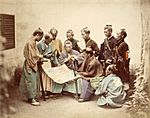Jōgen (Heian period) facts for kids
 |
|---|
|
Jōgen (貞元) was a special way to count years in Japan, like a short historical period. It was known as a Japanese era (nengō). This era came after Ten'en and before Tengen. The Jōgen period lasted from July 976 to November 978. During these years, Emperor En'yū (円融天皇) was the ruler of Japan.
Contents
What is a Japanese Era?
In ancient Japan, people didn't just use a single calendar year like we do today. They also used "era names" or nengō. Each era was chosen to mark important events or a new emperor's rule. It was a way to organize history and time.
When the Jōgen Era Began
The Jōgen era officially started on February 3, 976. This was a new beginning, as the previous era, Ten'en, had just ended. The change happened on the 13th day of the 7th month of 976, according to the old Japanese calendar.
Key Events of the Jōgen Era
The Jōgen era, though short, saw a few notable events that shaped the time.
Imperial Palace Fire
- June 11, 976 (Jōgen 1, 11th day of the 5th month): A huge fire broke out and destroyed the Imperial Palace. This was the main home and office of the emperor and his court. Such fires were a big problem in ancient cities, often built with wood.
Death of Fujiwara no Kanemichi
- December 20, 977 (Jōgen 2, 8th day of the 11th month): Fujiwara no Kanemichi passed away at the age of 51. He was a very powerful politician and a member of the Fujiwara clan. This family had a lot of influence over the emperors and the government during the Heian period. Kanemichi held important positions and played a big role in the politics of his time.

